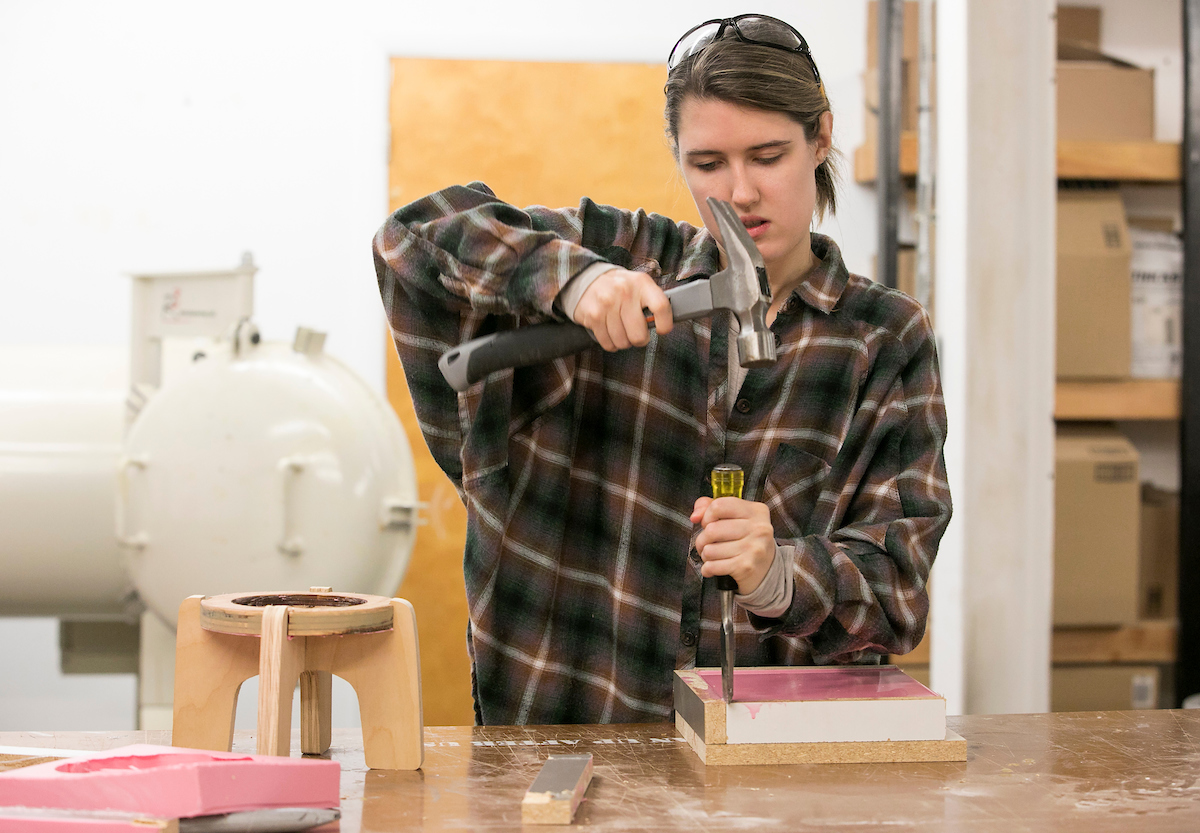
Interior Design and Industrial Design students step up with designs for 2018 Art Fair & Marketplace

When shoppers return to this year’s Art Fair & Marketplace at Columbus College of Art & Design on Saturday, Dec. 1, they’ll find a variety of art and design products, from high-end ceramic pieces that are also functional works of art to beautifully crafted jewelry to sassy home goods that bring some humor to everyday housework.
They’ll also find smartly designed home accessories created by students in Professor Joel Gundlach’s Furniture Design class.
This is the third year for Interior Design and Industrial Design juniors and seniors in the class to create home accessories for sale at the Art Fair. As in years past, their finished products will be mainly constructed out of Baltic birch plywood.
Previously, the students all designed stepstools. This year, they’re taking the next step with a variety of designs such as small tables and stands, trays, organizers, and more, created using a variety of tools, from a wood lathe for woodturning to a computer-programmed laser cutter to the Shopbot, a three-axis router that can cut wood, foam, and some metals.
The project requires students to not just conceive of and create a small piece of furniture, but to price it and sell it at the fair, said Gundlach. Adjunct Instructor Elaine Luttrull, a CPA, pays a visit to the class to talk to students about how to charge for their material costs, labor, and more. Final products are priced at about $50 to $100.
Part of the project requires students to be strategic and efficient in their work. “If I’m going to design this great thing that’s going to take me 17 hours to build, then I’m making $4 an hour,” Gundlach said. “I’m more valuable than that.”
After the students sketch, mock up, build, finish, and sell their work—and inevitably encounter challenges along the way—they head to the fair to sell their product. They create posters to describe their product's features, and work on a 30-second product pitch. They also have to make decisions about sales elements such as producing multiples of their work, taking orders, customization, and arranging pickups or deliveries of their products.
“This is where it’s really wonderful, because all of these consumers are going to come in, and they usually love the story,” said Gundlach. “It’s the art of the discussion. It’s here comes the consumer and how do I tell you in 30 seconds about my thing and get you to open up your wallet.”
Although many of the students may use high-tech tools to cut out, detail, or otherwise build some of their pieces, “there’s no magic button” for the journey,” said Gundlach. “You’ve got to live it and feel it”—and finish it to perfection.
“I’m fanatical about craft,” he said. “Someone’s going to come up and they’re going to touch the top edge (of a design) and say, ‘Oh, that’s really nice.’ It’s that moment where you can’t let them down.”
The goal with the finished piece, said Gundlach, is for it to have “a combination of function and really beautiful craft, a really beautiful shape.”
Among those who will be selling their designs is Catie Hade (Interior Design, 2019) whose magazine rack is meant for people who want to declutter their stacks of periodicals and show off their covers. The base of the rack is made of plywood, and magazines will hang on removable frosted acrylic strips that rest along the top of the rack.
It took some experimenting to land on a final design. “The silhouette has changed a lot. … at first, structurally, it was just not working,” she said. Now she’s planning on making multiples—one to keep for herself, and the rest to sell.
Maddie Russell (Interior Design, 2019) found inspiration for her work from her status as an aunt-to-be.
“I thought creating a stepstool could be something that I could pass down to a child,” she said. One side of the stool has a sleek curve, while the other is flat so the stool can go flush against a wall. Cutouts make carrying the stool easy.
“I made it in a way where your hand fits in there nicely,” she said.
“Most wine and cheese trays, they’re not really playful,” said Cecelia Garcia (Interior Design 2019). By contrast, her design features functional elements—cutouts providing offset spots for wine glasses, a bottle, and hors d’oeuvres, a silicone rest for the bottle to provide additional stability, a removable top layer to make cleaning a snap—with thoughtful details such as turned wood handles, curved edges, and laser etching that gives the appearance of an embroidered vine pattern.
“Dark stain will give it a luxurious, romantic look,” she said.
Garcia is using the Shopbot for precise cuts, which she will then sand to smoothness. Depending on how everything goes, she plans on making at least two trays (she wants to keep one for herself, too). And as she works on the finishing touches for her tray, Garcia is also polishing up her 30-second product pitch.
In addition to studying at CCAD, Garcia works at Sherwin Williams. “It’s easy to sell paint,” she said. “But when it comes to selling the process and explaining something you’ve built, it’s going to be challenging.”
The 2018 CCAD Art Fair & Marketplace is Saturday, Dec. 1, at the Loann Crane Center for Design (at the corner of Cleveland Avenue and Gay Street). The First Look is 9–11 a.m., General Admission: 11 a.m.–3 p.m.
Parking is free. Tickets ($7–$10 for General Admission, $25–$30 for First Look) are available online and at the door. Proceeds from ticket sales benefit CCAD student programming, and sales of art go directly to the artists and designers.
Post date
October 29, 2018